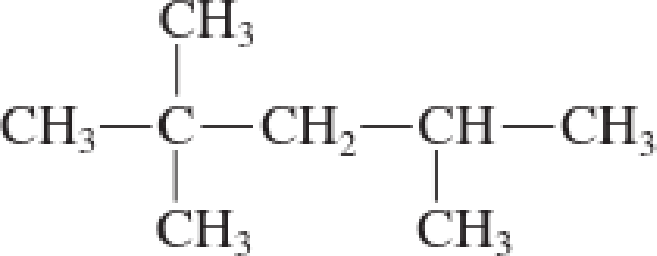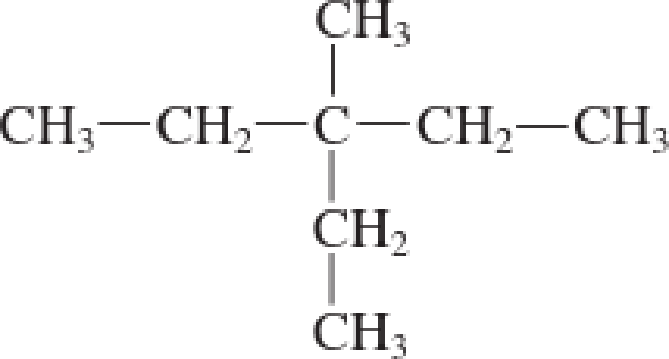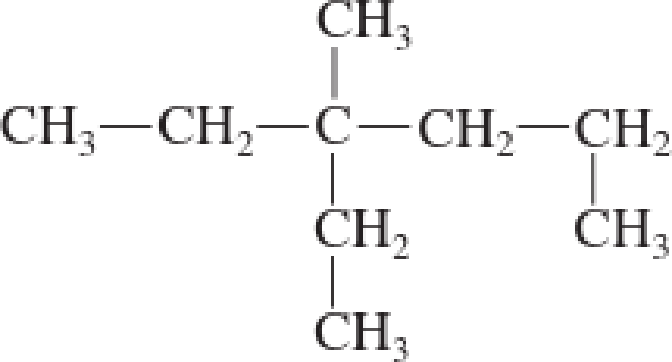
General, Organic, and Biological Chemistry
7th Edition
ISBN: 9781285853918
Author: H. Stephen Stoker
Publisher: Cengage Learning
expand_more
expand_more
format_list_bulleted
Concept explainers
Textbook Question
Chapter 12, Problem 12.69EP
Convert each of the condensed structural formulas in Problem 12-51 to a line-angle structural formula.
a. 
b. 
c. 
d. 
Expert Solution & Answer
Trending nowThis is a popular solution!

Students have asked these similar questions
2. Name the following hydrocarbons. (9 marks)
a)
HHHHHHHH
H-C-C-
H-O-S
b)
HCEC-CH3
H H
H H
H
d)
c)
H
C=C-
H
H
H
e)
CH3
CH3 CH2CH=CH-CH=CHCH3
HHHH
H-C-C-C-C-H
H
HH H
f)
large
CH2CH3
pola
H3C
section
lovels
tower,
able
ocart
firs g)
Tower
H3C-CH2
then in
H3C-CH-CH-CH3
enblbano bne noitsidab
Copyright © 2008. Durham Continuing Education
CH3
Name the molecules & Identify any chiral center
CH3CH2CH2CHCH₂CH₂CH₂CH₂
OH
CH₂CHCH2CH3
Br
CH3
CH3CHCH2CHCH2CH3
CH3
Curved arrows are used to illustrate the flow of electrons. Using the provided starting and product structures, draw the curved electrons-pushing arrows for the following reaction or mechanistic step(s).
Chapter 12 Solutions
General, Organic, and Biological Chemistry
Ch. 12.1 - Prob. 1QQCh. 12.1 - Prob. 2QQCh. 12.2 - Prob. 1QQCh. 12.2 - Prob. 2QQCh. 12.3 - Prob. 1QQCh. 12.3 - Prob. 2QQCh. 12.4 - Prob. 1QQCh. 12.4 - Prob. 2QQCh. 12.4 - Prob. 3QQCh. 12.5 - Prob. 1QQ
Ch. 12.5 - Prob. 2QQCh. 12.5 - Prob. 3QQCh. 12.6 - Prob. 1QQCh. 12.6 - Prob. 2QQCh. 12.6 - Prob. 3QQCh. 12.6 - Prob. 4QQCh. 12.7 - Prob. 1QQCh. 12.7 - Prob. 2QQCh. 12.8 - Prob. 1QQCh. 12.8 - Prob. 2QQCh. 12.8 - Prob. 3QQCh. 12.8 - Prob. 4QQCh. 12.8 - Prob. 5QQCh. 12.8 - Prob. 6QQCh. 12.8 - Prob. 7QQCh. 12.9 - Prob. 1QQCh. 12.9 - Prob. 2QQCh. 12.10 - Prob. 1QQCh. 12.10 - Prob. 2QQCh. 12.11 - Prob. 1QQCh. 12.11 - Prob. 2QQCh. 12.11 - Prob. 3QQCh. 12.12 - Prob. 1QQCh. 12.12 - Prob. 2QQCh. 12.12 - Prob. 3QQCh. 12.13 - Prob. 1QQCh. 12.13 - Prob. 2QQCh. 12.13 - Prob. 3QQCh. 12.14 - Prob. 1QQCh. 12.14 - Prob. 2QQCh. 12.14 - Prob. 3QQCh. 12.15 - Prob. 1QQCh. 12.15 - Prob. 2QQCh. 12.16 - Prob. 1QQCh. 12.16 - Prob. 2QQCh. 12.16 - Prob. 3QQCh. 12.17 - Prob. 1QQCh. 12.17 - Prob. 2QQCh. 12.17 - Prob. 3QQCh. 12.17 - Prob. 4QQCh. 12.18 - Prob. 1QQCh. 12.18 - Prob. 2QQCh. 12.18 - Prob. 3QQCh. 12.18 - Prob. 4QQCh. 12 - Prob. 12.1EPCh. 12 - Prob. 12.2EPCh. 12 - Prob. 12.3EPCh. 12 - Prob. 12.4EPCh. 12 - Indicate whether each of the following situations...Ch. 12 - Indicate whether each of the following situations...Ch. 12 - Prob. 12.7EPCh. 12 - Prob. 12.8EPCh. 12 - What is the difference between a saturated...Ch. 12 - Prob. 12.10EPCh. 12 - Prob. 12.11EPCh. 12 - Prob. 12.12EPCh. 12 - Prob. 12.13EPCh. 12 - Prob. 12.14EPCh. 12 - Prob. 12.15EPCh. 12 - Prob. 12.16EPCh. 12 - Prob. 12.17EPCh. 12 - Prob. 12.18EPCh. 12 - Convert the expanded structural formulas in...Ch. 12 - Prob. 12.20EPCh. 12 - Prob. 12.21EPCh. 12 - Prob. 12.22EPCh. 12 - Prob. 12.23EPCh. 12 - Prob. 12.24EPCh. 12 - Prob. 12.25EPCh. 12 - Prob. 12.26EPCh. 12 - Indicate whether each of the following would be...Ch. 12 - Indicate whether each of the following would be...Ch. 12 - Prob. 12.29EPCh. 12 - Prob. 12.30EPCh. 12 - Prob. 12.31EPCh. 12 - Prob. 12.32EPCh. 12 - Prob. 12.33EPCh. 12 - How many of the numerous seven-carbon alkane...Ch. 12 - Prob. 12.35EPCh. 12 - For each of the following pairs of structures,...Ch. 12 - Prob. 12.37EPCh. 12 - Prob. 12.38EPCh. 12 - Prob. 12.39EPCh. 12 - Prob. 12.40EPCh. 12 - Prob. 12.41EPCh. 12 - What is the name of the IUPAC prefix associated...Ch. 12 - What is the IUPAC name for each of the following...Ch. 12 - What is the IUPAC name for each of the following...Ch. 12 - Prob. 12.45EPCh. 12 - What is the chemical formula for each of the...Ch. 12 - Prob. 12.47EPCh. 12 - Prob. 12.48EPCh. 12 - Prob. 12.49EPCh. 12 - Prob. 12.50EPCh. 12 - Prob. 12.51EPCh. 12 - Prob. 12.52EPCh. 12 - Draw a condensed structural formula for each of...Ch. 12 - Draw a condensed structural formula for each of...Ch. 12 - Prob. 12.55EPCh. 12 - Prob. 12.56EPCh. 12 - Explain why the name given for each of the...Ch. 12 - Prob. 12.58EPCh. 12 - Indicate whether or not the two alkanes in each of...Ch. 12 - Prob. 12.60EPCh. 12 - How many of the 18 C8 alkane constitutional...Ch. 12 - Prob. 12.62EPCh. 12 - Prob. 12.63EPCh. 12 - Prob. 12.64EPCh. 12 - Prob. 12.65EPCh. 12 - Prob. 12.66EPCh. 12 - Do the line-angle structural formulas in each of...Ch. 12 - Do the line-angle structural formulas in each of...Ch. 12 - Convert each of the condensed structural formulas...Ch. 12 - Convert each of the condensed structural formulas...Ch. 12 - Assign an IUPAC name to each of the compounds in...Ch. 12 - Prob. 12.72EPCh. 12 - Prob. 12.73EPCh. 12 - Prob. 12.74EPCh. 12 - For each of the alkane structures in Problem...Ch. 12 - Prob. 12.76EPCh. 12 - Prob. 12.77EPCh. 12 - Prob. 12.78EPCh. 12 - Prob. 12.79EPCh. 12 - Prob. 12.80EPCh. 12 - Prob. 12.81EPCh. 12 - Prob. 12.82EPCh. 12 - Draw condensed structural formulas for the...Ch. 12 - Draw condensed structural formulas for the...Ch. 12 - To which carbon atoms in a hexane molecule can...Ch. 12 - Prob. 12.86EPCh. 12 - Prob. 12.87EPCh. 12 - Prob. 12.88EPCh. 12 - Prob. 12.89EPCh. 12 - Prob. 12.90EPCh. 12 - Prob. 12.91EPCh. 12 - Prob. 12.92EPCh. 12 - Prob. 12.93EPCh. 12 - Using the general formula for a cycloalkane,...Ch. 12 - Prob. 12.95EPCh. 12 - Prob. 12.96EPCh. 12 - Prob. 12.97EPCh. 12 - Prob. 12.98EPCh. 12 - How many secondary carbon atoms are present in...Ch. 12 - Prob. 12.100EPCh. 12 - Prob. 12.101EPCh. 12 - Assign an IUPAC name to each of the following...Ch. 12 - Prob. 12.103EPCh. 12 - What is wrong with each of the following attempts...Ch. 12 - Draw line-angle structural formulas for the...Ch. 12 - Draw line-angle structural formulas for the...Ch. 12 - Prob. 12.107EPCh. 12 - Prob. 12.108EPCh. 12 - Prob. 12.109EPCh. 12 - Prob. 12.110EPCh. 12 - Determine the number of constitutional isomers...Ch. 12 - Determine the number of constitutional isomers...Ch. 12 - Prob. 12.113EPCh. 12 - Determine whether cistrans isomerism is possible...Ch. 12 - Prob. 12.115EPCh. 12 - Prob. 12.116EPCh. 12 - Prob. 12.117EPCh. 12 - Indicate whether the members of each of the...Ch. 12 - Prob. 12.119EPCh. 12 - Prob. 12.120EPCh. 12 - Prob. 12.121EPCh. 12 - Prob. 12.122EPCh. 12 - Which member in each of the following pairs of...Ch. 12 - Prob. 12.124EPCh. 12 - Prob. 12.125EPCh. 12 - Prob. 12.126EPCh. 12 - Answer the following questions about the...Ch. 12 - Prob. 12.128EPCh. 12 - Prob. 12.129EPCh. 12 - Prob. 12.130EPCh. 12 - Prob. 12.131EPCh. 12 - Prob. 12.132EPCh. 12 - Prob. 12.133EPCh. 12 - Write structural formulas for all the possible...Ch. 12 - Assign an IUPAC name to each of the following...Ch. 12 - Assign an IUPAC name to each of the following...Ch. 12 - Prob. 12.137EPCh. 12 - Prob. 12.138EPCh. 12 - Prob. 12.139EPCh. 12 - Draw structural formulas for the following...Ch. 12 - Prob. 12.141EPCh. 12 - Prob. 12.142EPCh. 12 - Prob. 12.143EPCh. 12 - Prob. 12.144EPCh. 12 - Prob. 12.145EPCh. 12 - Prob. 12.146EPCh. 12 - Prob. 12.147EPCh. 12 - Prob. 12.148EP
Knowledge Booster
Learn more about
Need a deep-dive on the concept behind this application? Look no further. Learn more about this topic, chemistry and related others by exploring similar questions and additional content below.Similar questions
- Curved arrows are used to illustrate the flow of electrons. Using the provided starting and product structures, draw the curved electrons-pushing arrows for the following reaction or mechanistic step(s).arrow_forwardWhat is the IUPAC name of the following compound? CH₂CH₂ H CI H₂CH₂C H CH₂ Selected Answer: O (35,4R)-4 chloro-3-ethylpentane Correctarrow_forwardCurved arrows are used to illustrate the flow of electrons. Using the provided starting and product structures, draw the curved electrons-pushing arrows for the following reaction or mechanistic step(s).arrow_forward
- Curved arrows are used to illustrate the flow of electrons. Using the provided starting and product structures, draw the curved electron-pushing arrows for the following reaction or mechanistic step(s). Be sure to account for all bond-breaking and bond-making steps. I I I H Select to Add Arrows HCI, CH3CH2OHarrow_forwardCurved arrows are used to illustrate the flow of electrons. Use the reaction conditions provided and the follow the arrows to draw the intermediate and product in this reaction or mechanistic step(s).arrow_forwardCurved arrows are used to illustrate the flow of electrons. Use the reaction conditions provided and follow the curved arrows to draw the intermediates and product of the following reaction or mechanistic step(s).arrow_forward
- Curved arrows are used to illustrate the flow of electrons. Use the reaction conditions provided and follow the arrows to draw the intermediate and the product in this reaction or mechanistic step(s).arrow_forwardLook at the following pairs of structures carefully to identify them as representing a) completely different compounds, b) compounds that are structural isomers of each other, c) compounds that are geometric isomers of each other, d) conformers of the same compound (part of structure rotated around a single bond) or e) the same structure.arrow_forwardGiven 10.0 g of NaOH, what volume of a 0.100 M solution of H2SO4 would be required to exactly react all the NaOH?arrow_forward
- 3.50 g of Li are combined with 3.50 g of N2. What is the maximum mass of Li3N that can be produced? 6 Li + N2 ---> 2 Li3Narrow_forward3.50 g of Li are combined with 3.50 g of N2. What is the maximum mass of Li3N that can be produced? 6 Li + N2 ---> 2 Li3Narrow_forwardConcentration Trial1 Concentration of iodide solution (mA) 255.8 Concentration of thiosulfate solution (mM) 47.0 Concentration of hydrogen peroxide solution (mM) 110.1 Temperature of iodide solution ('C) 25.0 Volume of iodide solution (1) used (mL) 10.0 Volume of thiosulfate solution (5:03) used (mL) Volume of DI water used (mL) Volume of hydrogen peroxide solution (H₂O₂) used (mL) 1.0 2.5 7.5 Time (s) 16.9 Dark blue Observations Initial concentration of iodide in reaction (mA) Initial concentration of thiosulfate in reaction (mA) Initial concentration of hydrogen peroxide in reaction (mA) Initial Rate (mA's)arrow_forward
arrow_back_ios
SEE MORE QUESTIONS
arrow_forward_ios
Recommended textbooks for you
 Organic And Biological ChemistryChemistryISBN:9781305081079Author:STOKER, H. Stephen (howard Stephen)Publisher:Cengage Learning,
Organic And Biological ChemistryChemistryISBN:9781305081079Author:STOKER, H. Stephen (howard Stephen)Publisher:Cengage Learning, General, Organic, and Biological ChemistryChemistryISBN:9781285853918Author:H. Stephen StokerPublisher:Cengage Learning
General, Organic, and Biological ChemistryChemistryISBN:9781285853918Author:H. Stephen StokerPublisher:Cengage Learning
 Chemistry: The Molecular ScienceChemistryISBN:9781285199047Author:John W. Moore, Conrad L. StanitskiPublisher:Cengage Learning
Chemistry: The Molecular ScienceChemistryISBN:9781285199047Author:John W. Moore, Conrad L. StanitskiPublisher:Cengage Learning Introductory Chemistry: An Active Learning Approa...ChemistryISBN:9781305079250Author:Mark S. Cracolice, Ed PetersPublisher:Cengage Learning
Introductory Chemistry: An Active Learning Approa...ChemistryISBN:9781305079250Author:Mark S. Cracolice, Ed PetersPublisher:Cengage Learning ChemistryChemistryISBN:9781305957404Author:Steven S. Zumdahl, Susan A. Zumdahl, Donald J. DeCostePublisher:Cengage Learning
ChemistryChemistryISBN:9781305957404Author:Steven S. Zumdahl, Susan A. Zumdahl, Donald J. DeCostePublisher:Cengage Learning

Organic And Biological Chemistry
Chemistry
ISBN:9781305081079
Author:STOKER, H. Stephen (howard Stephen)
Publisher:Cengage Learning,

General, Organic, and Biological Chemistry
Chemistry
ISBN:9781285853918
Author:H. Stephen Stoker
Publisher:Cengage Learning


Chemistry: The Molecular Science
Chemistry
ISBN:9781285199047
Author:John W. Moore, Conrad L. Stanitski
Publisher:Cengage Learning

Introductory Chemistry: An Active Learning Approa...
Chemistry
ISBN:9781305079250
Author:Mark S. Cracolice, Ed Peters
Publisher:Cengage Learning

Chemistry
Chemistry
ISBN:9781305957404
Author:Steven S. Zumdahl, Susan A. Zumdahl, Donald J. DeCoste
Publisher:Cengage Learning
ENVIRONMENTAL POLLUTION; Author: 7activestudio;https://www.youtube.com/watch?v=oxtMFmDTv3Q;License: Standard YouTube License, CC-BY